VIEW BY TOPIC
- Finding Customers
- Business Systems
- Managing Employees
- Leadership
- Managing Money
Related Posts

Ready to Grow Your Business Fast?
Here’s How I Grew Five Businesses, and Eventually Sold One to a Fortune 500 Company.

The Ultimate Guide To Creating a Business Plan
Every small business owner needs a business plan to guide strategy and growth.
A good business plan separates failing small businesses from successful ones.
We regularly see our clients increase their profits by 50%, 400%, and even 1,500% starting with a proper plan as one of their most powerful business growth strategies, allowing them to make conscious and informed decisions.
This guide will teach you steps that will assure a steady growth of your business using one of the most rudimentary, yet overlooked strategies: writing a business plan.
How Does Writing a Business Plan Impact Your Business?
We said that planning is one of the most pivotal business growth strategies.
But how does it work within the big picture?
Say you have your business rolling for quite a while now. It’s not growing fast, but it’s not stagnant.
What you’re missing could be the reason most businesses fail within their first year.
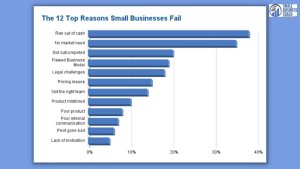
CB Insights recognize multiple reasons for small businesses to fail, from failure to raise capital to personnel issues to pricing issues.
But look closely at the chart.
What do all these reasons have in common?
If you’re thinking ‘a viable business plan’, you’re right.
The first thing we ever ask of our clients is to delineate where they would like to be and how they see themselves getting there. It turns out that if you do not plan your way towards success—or even worse; you don’t know what success would look like for you—it is hard to get there.
For entrepreneurs who move quickly and like to get right to the point, planning might seem like a formality or useless paperwork when in fact, executed properly, planning is the foundation of business growth.
- A business plan compels you to analyze the current state of your business. So, instead of overlooking your business needs, you’ll overcome situations before they turn into challenges.
- Knowing where you are, you can analyze and pursue opportunities for business growth. You gain a better perspective of what you can do now to expand your business, be it finding new prospects, building and managing your team better or systematizing your internal processes and procedures.
- When you know what the ideal future of your business looks like, you have a clearer perspective on what your priorities are. You should see planning as a strategic framework that guides your decision-making process. This way, making decisions regarding your business will be less a game of guesswork and more a game of taking strategic action.
- When you know where you want your business to be in the far future, you can better track your near future. Another way to put it, a business plan provides you with key performance indicators that will help measure the progress towards your business goal
Typically, a business plan requires you to assess all aspects of your activity.
A standard business plan usually includes an executive summary, a business overview, business objectives, a description of products and services, an overview of market opportunities, sales, and marketing strategies, a competitive analysis, a financial auditing, a financial analysis, and a delineation of the management structure.
While useful for raising capital, these standard plans are the reason many business owners’ eyes glaze over when they think about developing a plan
Instead, our approach to business planning is a little different…
We take planning to the next level.
This guide shows you how to use planning to envision the actionable steps towards your goal.
All that using the knowledge you gathered in a traditional business plan.

This means analyzing the current situation including a SWOT Analysis, creating a business plan around the weaknesses that need immediate attention, setting hard and fast deadlines for accountability, and tracking your progress in terms of business KPIs.
First, we’ll make sure you make an informed decision when choosing your goal, meaning that we will walk you through how to make a thorough audit of your current situation.
Then we’ll help you write clear-cut business KPIs that will guide your future tactics and strategies.
And finally, we will guide you through planning actionable steps to achieve your goals, and show you how to measure your success.
A successful business plan factors in these elements
Step 1. Analyze Your Business To Identify Your Strengths and Weaknesses
To make long-lasting and growth-inducing changes, treat your business with honesty.
A business plan imposes a thorough (and sincere) inspection of the state of facts within your business. So the change s you make are congruent with the reality of your activity.
s you make are congruent with the reality of your activity.
Once you’re well acquainted with the present state of your business, you can spot new growth opportunities.
Now, it’s time for you to touch base with your business.
Your Activity as a Business
Start by revisiting your core business activities.
You have already sent your services and products out into the world for people to enjoy. Hence, you have enough data to learn about your offer.
To take the pulse of your business, ask yourself the following questions.
- Which products or services work well in your target market? Which are not?
- Do you find that your products or services still fit the needs of your audience? And if they don’t, what doesn’t work? Analyze the cause of low performance (price, packa
 ging, sales, marketing, functioning, etc.).
ging, sales, marketing, functioning, etc.). - Your target market – is it overly saturated with this type of product? If the answer is ‘yes’, is there something that differentiates your service from your competitors?
- What is the distinct value of your services to your customers?
- When was the last time you reviewed your prices? Can you improve your profits and the quality of your services by making changes in your pricing, package offerings, service delivery, and so on?
- Your team – are they motivated? Do they perform the way you want them to every day, or is it a constant battle to get work done the way you want it done?
- Do you have standard, documented processes, and procedures that guide you and your employees to produce consistent results every time?
Take time to answer all of these questions. And don’t forget to take notes along the way.
The Efficiency of Your Internal Organization and Processes
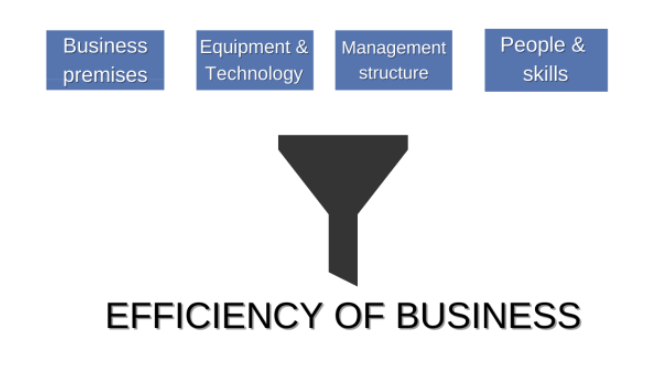 There’s a lot to analyze in terms of efficiency.
There’s a lot to analyze in terms of efficiency.
From the grounds where you conduct your activity and the equipment, you use to the efficiency of your management structure and the skills of your employees.
So, buckle up! You’ve got some reviewing to do.
Business Premises
When it comes to where your business is located, ask yourself: is this place responding to our business needs now & does it allow us to grow?
Although they are easily overlooked, your business premises should contribute to your small business success.
- Do you have long-term commitments to the property?
- Do the premises present you with advantages or disadvantages?
- Is moving out an option to reduce costs?
Equipment and Technology
Whether your business rests on services, manufacturing, retail or you carry out your activities exclusively online, you use equipment and software.
Is your equipment modern or outdated? Does it help you to better execute your activity? Will new equipment help you speed up processes, reduce costs, or improve services?

When it comes to IT systems…
- What software, platforms, or gadgets do you use in your activity? Are they sufficient to help you provide outstanding services or products?
And more…
- Can you use them for growth? When your business grows, will they meet your needs?
- Are there any new devices, informational systems, or tools that you can use to improve the quality of your products or services or to streamline your internal processes?
The People of Your Business

By this, we refer to everyone who works in your business including yourself, employees and subcontractors.
Let’s first look at your management structure.
And the first question you require an answer to is: is your current team formed by the right people?
- Do they constantly learn and grow?
- Does their performance meet your expectations? Is your business thriving under their management?
- Are they attuned to the company’s values?
- Do they have the appropriate skills for their positions?
And the next question is: do YOU have the right skills to guide your business towards growth?
Be honest. The point of this question is to guide you to learn where you can improve and where your teams need more training.
This leads us to the questions about your employees.
- How skillful are your employees?
- Do you have a training structure in place to assure the constant growth of your business performance?
- Do you think that your employee engagement is high? Find out if your employees are aligned with the company’s goals. Moreover, are they satisfied with their work?
- What are you doing to keep up the employee engagement and satisfaction?
Your Business Through the Lens of Competition

You know by now that you’re not alone in the market. You’re surrounded by businesses that want your customers!
This means that you’ll have to know your competition well, provided you want to find growth opportunities.
To learn about your competition, get curious about this:
- What is their offer in opposition to yours? What are their market advantages and disadvantages?
- How do they price their products and services?
- And how do they advertise their products, services, and themselves?
- How do they attract customers?
- What’s their reputation in the market?
Consider ‘secret shopping’ them to learn the answers and see what it feels like to be their customer.
Learning this information will help you identify opportunities to grow your business in a place where your competition won’t.
Your Business from a Financial Standpoint

We’re saying it, and you should be thinking it—manage your business by numbers.
Poor finance management will bury your business alive.
To avoid that happening, take some time to review your financial statements: cash flow statement, balance sheet, and profit and loss statement. If you don’t know what to make up of all that information, get your accountant beside you.
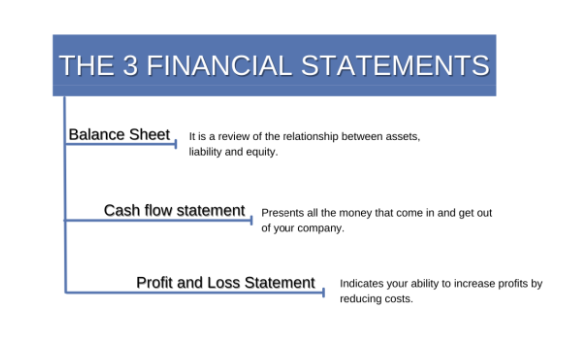
This is what each of these statements will tell you.
This type of investigation will make you familiar with how your business is using and producing money. And this will show you if you’re using your money efficiently.
Finding Market Opportunities
As you might have guessed, this implies doing further research about your customers and your market.
You must renew your market research because markets shift. Trends evolve. People change their minds.
You have to know what’s happening out there so that your business can take part in it.
- What are the actual market demands and needs? Interview some of your clients.
- What’s the present business environment – aka the economy, the technological developments, social changes?
- Are there new, emerging services and products creating more competition?
Step 2. Write Informed and Clear Business KPI To Guide Your Business Growth
Dare not skip this step!
It is imperative that you answer each question and complete each task in this step.
Because, otherwise, we would have to ask you:
Are you sure you want to grow your business?
If your answer is yes, let’s get you to write a business plan like an expert.
For this section, you will use your previously gained knowledge to write a business KPI that will constantly remind you of your path to small business success.
What is a Business KPI?

KPI stands for Key Performance Indicators—a quantifiable measurement you choose to help you gauge your progress towards business success.
You can use KPIs to measure almost every aspect of your business: financial achievements, operational activities, marketing efforts… ANYTHING. Nevertheless, KPIs differ from business to business, industry to industry.
So don’t copy what others do. You have to find out on your own what is critical to you and your business.
That’s why, first and foremost, you will have to select the area that you want to improve for your business.
How Do You Know Which Business KPI to Select?

With the help of your previous analysis (and your fellow knowledgeable business coach), you will identify what stands in the way of your business growth.
Is it your employees that require a nudge? Are you leaking money in the manufacturing department? Is your marketing not rising to your expectations?

Task 1: Identify One Pressing Business Weakness.
KPIs also depend on the past (background data) & on where you want to be in the future.


Task 2: Think of What Long-term Success Looks Like. Then Find a Benchmark to Gauge Short-term Success.
Side note.
Be careful what success metric you choose. Let’s say you find that your employee training programs don’t show astounding results. And you want to change that.
The improvements won’t produce better results in the training program in itself. You should see upgrades in the decrease of errors in product production.
Why Choose Only One Business KPI?

Your business is a complex mechanism working on thousands of integrated and interconnected points and systems.
So it’s a matter of course that changing one thing will affect the entire business.
But you can’t make changes in each segment of your business that needs improving in one go.
That would wreak havoc on your business!
You will not know for sure what does and doesn’t work. And it would be difficult for you to measure and keep track of what’s going on.
For this reason, we will track one thing at a time.
Do you need inspiration for finding your business KPI? Here are some ideas.
What Makes up a Good KPI?
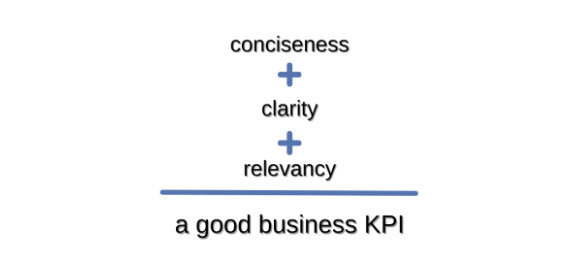
A great KPI is succinct, straightforward, and relevant.
Consider these questions when writing your KPIs:
- How do you want your business to perform in the future? What are your projections?
- Why are these projected results important?
- How are you going to gauge any changes in numbers?
- What will you do to achieve the projected results?
- Who will oversee this project?
- How often will you evaluate the potential advancements?
Task 3: Write Your Business KPI, Answering Each of the 6 Preceding Questions.
Get ready, for you’re about to reach the—almost—last step in creating a business.
Step 3. Implement Your Plan and Measure the Results To Ensure Small Business Success
Here’s the process of action planning for business success and measuring the results.
Action Planning for Business Success

You should approach implementation through the lens of an action plan. Why action planning?
Because it is the utmost actionable part of your business plan.
It provides an explicit delineation of what steps you should be taking to achieve your goals. It aligns your actions to your objectives. And, finally, it saves you from guesswork.
Now it’s time to prepare the list of tasks that will get you to your goal.
And to achieve your KPI.
Meaning honoring your business.
This also means growing your business.
We’ll return to our thought bubble.
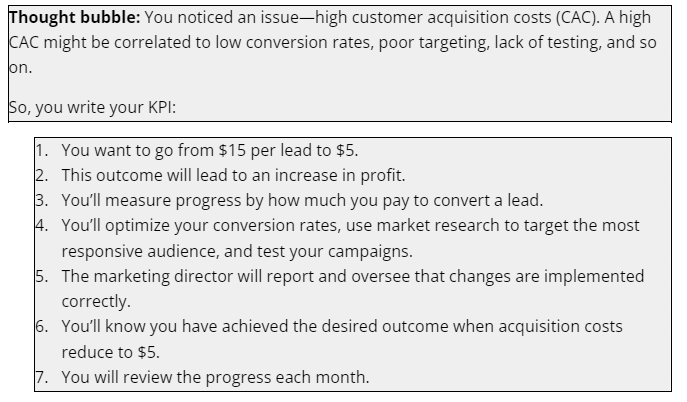
If you have followed each step, at this moment, your action plan is half done.
What more you need to do is to expand on point 4: “how can you influence the outcome”.
You’ll have to:

- Write down each activity that needs to be done and break them down into tasks.
- Designate the action or specific tasks to a staff member.
- Determine a timeline for each task.
- Identify what resources you and your team need to complete the tasks.
Then, all you have left to do is get things rolling.
Measuring the Growth of Your Business
Do you remember when we asked you to be specific about your KPI? Well, the time has come to check on how things are going according to your benchmarks.

Generally, you would review the performance of your business every quarter. But this timeframe may not be relevant to your business plan.
When you measure results, you go back to the initial source of information that you have used when analyzing your business. For example, when you had checked the performance metric indicating your conversion rate, you perhaps used a CRM. Now, you should go back to your CRM and look at the stats.
Take notes and compare them with your projected results.
Is everything going according to the plan? Or are the results signaling that you need to come up with new business growth strategies?

If results don’t live up to your expectations, don’t fret. Go back to
your business plan, tweak it a little, consult with your stakeholders or business coach, and try again.
Rome wasn’t built in a day.
How to create an action plan [+ Template]
Do You Need More Guidance in Planning the Growth of Your Business?

Find more freedom and raise your profits with one-on-one business coaching sessions.
If you struggle to find the optimal direction to grow your business, we can help you. No need to commit to the entire coaching program. For now, jump on a 30-minute strategy session.
Before the meeting, we will send you a scorecard or a survey. Before and during the session, we will review the information you submitted, and we will help you figure out the next steps for your business.















